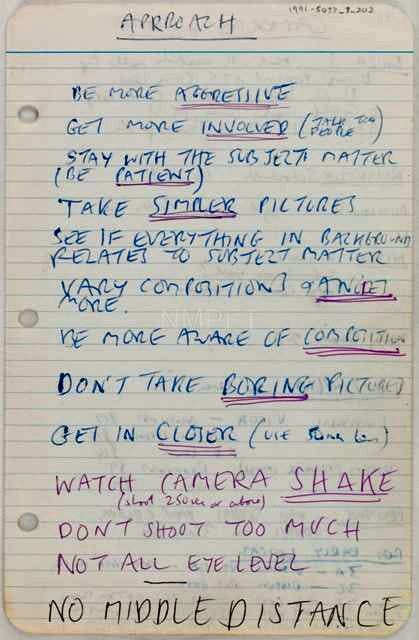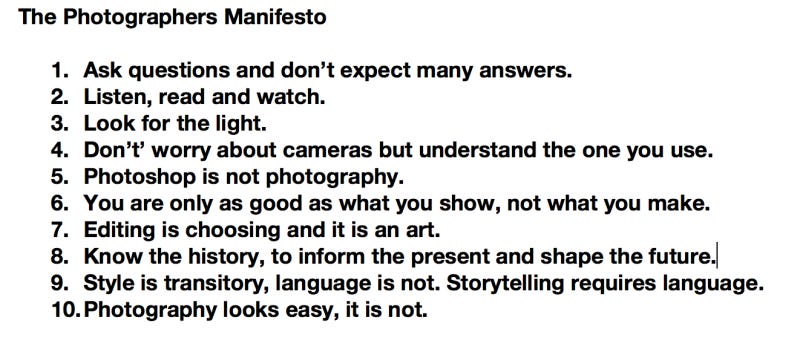I'm Thinking Of Writing Myself A Photography Manifesto
But I have questions. What if it's just a load of old fluff?
Pinned to my wall (well, blu-tacked to be honest) is ‘A Manifesto’ by Martin Parr1 - subtitled ‘10 rules for emerging photographers’.
Stuck into one of my journal type notebooks is a photocopy of another similar document entitled ‘Approach’ by Tony Ray Jones2.
And photographer and educator Grant Scott3 also has a version - ‘The Photographers Manifesto’ which he shared on his United Nations of Photography blog.
There are others which you can find online, drawn up by less well known photographers, and even some ‘experts’, and yet others that are aimed specifically towards certain genres of photography, such as street photography or nature photography.
I’ve been trying to think about what they might mean, their purpose, why they might be considered a useful or good idea, whether in fact they are useful, whether they might apply to me, whether I should have my own, whether every photographer should. Or in fact whether it’s all just a load of old fluff (there is, after all, a lot of fluff in this world!). Lots of questions.
But first, for reference, these are the manifestos that I’ve just referred to:
What is a manifesto?
I guess the only time a lot of us come across the word manifesto is either in the context of art history (some of the 20C art movements delighted in writing manifestos), or in relation to an election where promises are made as to what a particular political party will do if elected.
Merriam-Webster defines a manifesto as: “a written statement declaring publicly the intentions, motives, or views of its issuer”. It’s an obvious thing to say, then, but this makes manifestos subjective - which of course they are. They are the outlook and objectives of a particular person or group at a particular time. They are not universal. Even a photography manifesto written by a sainted and lauded photographer (who could I be talking about - I wonder?) is not universal; it’s not gospel. Which takes me a little way towards the answer to one of my questions: “Should I have one?”. I think the answer, obviously, is if I want to have one, if it meets a need of mine that I recognise, then yes.
Codifying my thinking
In lots of different situations I find it helpful to codify my thinking: set it down in writing so that I can refer back to it and so that it keeps me on the straight and narrow. In fact, I think it’s pretty much what I’m doing right now as I write this post - using the medium of writing to sort out what I think.
I reckon many of us struggle with being quite scattergun in our approach to what we do - I certainly do - and sometimes we need a guide. So why not a guide that we ourselves create? It doesn’t need to be published - it doesn’t need to be pretty. It needs to be meaningful, real and address our actual situation. It might be good for one project, one roll of film, one day… or it might be more long lasting, holistic and directional. It might be that both are valuable at the same time for different purposes. It needs to fit our requirement(s) - our individual requirement(s) at the time it’s written.
Thinking about it, I realise that I try to codify my thinking about my photography all the time so that I can explain it to others. From the snippets at the top of my Instagram profile, or my Substack (!) to the about page on my website and the design of my business cards. I’m doing it all the time, so why not give myself a break and a guide? If I can explain to myself what I’m doing, I have a better chance of explaining it to others.
An honest approach
Of the three ‘manifestos’ above, I think the one that gels most with me is Tony Ray Jones’ document. The main part of it seems as though it may have been written quite quickly, maybe on the spur of the moment, thinking ahead to photographs he is about to take. And - wonderfully, engagingly - it has been added to, underlined, emphasised as if he is telling himself definitely not to forget certain important things. It’s a working document, and I love it for its honesty and its simplicity. It puts me in mind of the list that Alec Soth4 made, for his book A Pound of Pictures (2022), of photographs he was searching for/didn’t want to miss during his photo-gathering journeys. It’s real, it’s immediate and it’s useful.
The other reason I love this is it is Tony Ray Jones giving advice only to himself, not to other people. There’s a lot of advice out there, and many people who want to give it. But for me there is nothing that beats thinking through myself why I’m doing something - getting it right in my own head. The more I go on, the more I recognise there is no shortcut to me understanding what I do, and why I do it - it’s just hard, persistent, but rewarding, work.
The other two manifestos referenced above are all about ‘you’ - they are advice being given. Don’t get me wrong, they have their place, this is good advice, it is the fruit of years of (successful) practice so should not be ignored. And I think that receiving advice and input from others that I trust is vital; critical for my development. I value it hugely. But by following the advice on its own, without also doing the hard work of understanding myself, my own practice and motivations and my own objectives and intentions, it seems to me I would be gaining far less than I might.
So, maybe that’s a couple more of my earlier questions answered - yes, as well as the hard, solid, trusted stuff, there’s plenty of fluff out there, but that doesn’t mean that writing an approach or a manifesto for myself can’t be extremely useful.
So, yes or no?
So, yes. I think I’ve come to the conclusion that writing an ‘approach’ - I like that word better than ‘manifesto’ - could be a very beneficial thing for me to do. And it will require some serious thinking about, so it’s something that I’ll spend some time on and come back to - maybe in my next newsletter if I’ve got it together by then, maybe in a later one.
I see it as a part of learning about myself, and a part of loosing the ties of doing what I do for ‘likes’ or to achieve the approval of others. Or making photos that look a certain way because that’s what I can see might just ‘succeed’. It’s about being true to me. Becoming stronger. Believing in myself more. Becoming more free.
If I can put something together that helps me do that, it will be worthwhile and I’ll be very happy. Let’s see.
Finish on a photo
It’s always nice to at least finish on a photo. This is, to me, quite an honest photo. I was reading Hotshoe in a deckchair in the garden on a lovely summer’s day, got up, saw the picture and took it. It speaks to me, I get a little zing looking at it, I understand it, it’s true. I honestly don’t know if that comes across - if it does anything at all for anyone else. Whether it’s ‘good’ or not is not really for me to say. Nevertheless, I love it - always have.
The sting in the tail is that I did this seventeen years ago. And whilst I’ve hopefully become a better technical photographer since then - I’ve learnt more, I know more - I wonder whether I continue to be free enough to make a photo like this now?
I think I might need to write myself an ‘approach’.
As always, thank you for stopping by and I hope you have enjoyed this newsletter. Any questions or comments, please don’t hesitate to get in touch. I’d love to hear from you.
Until next time, take care and God bless,
Keith
Martin Parr (born 1952) is one of the best-known documentary photographers of his generation. With over 100 books of his own published, and another 30 edited by Parr, his photographic legacy is already established. [Magnum Photos]
Tony Ray-Jones (1941-1972) was an influential British post-war photographer who is best remembered for his light-hearted, quirky images of the English social landscape. [Centre for British Photography]
Dr Grant Scott: After fifteen years art directing photography books and magazines such as Elle and Tatler, Scott began to work as a photographer for a number of advertising and editorial clients in 2000. Alongside his photographic career Scott has art directed numerous advertising campaigns, worked as a creative director at Sotheby’s, art directed foto8 magazine, founded his own photographic gallery, edited Professional Photographer magazine and launched his own title for photographers and filmmakers Hungry Eye. [United Nations of Photography]
Alec Soth (born 1969) is a photographer born and based in Minneapolis, Minnesota. He has published over thirty books including Sleeping by the Mississippi (2004), NIAGARA (2006), Broken Manual (2010), Songbook (2015), I Know How Furiously Your Heart is Beating (2019), A Pound of Pictures (2022), and Advice for Young Artists (2024). [alecsoth.com]







I’d not seen the Ray-Jones text before. He seems to have anticipated John Baldessari’s instruction to “not make any more boring art.” Looking forward to reading your manifesto (or whatever you decide to call it), assuming you’ll share it here. It’s always useful to have a plan so that you can occasionally diverge from it.
To me that is a very introspective and navel gazing approach which might get in the way of 'just being' and clogs up the artist. I suggest relaxing into your photography and be free and just do it. Just saying!